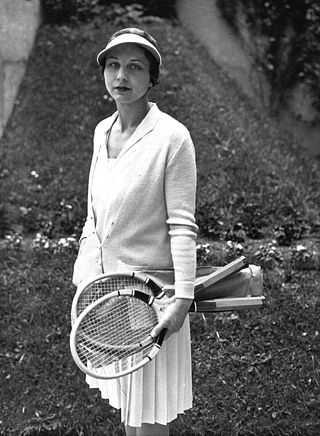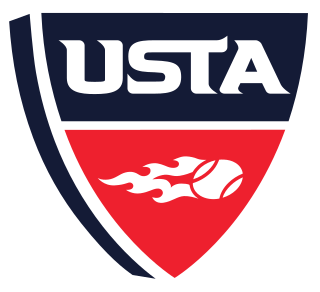Results
Total wins:![]() United States 51–10
United States 51–10![]() United Kingdom [10]
United Kingdom [10]
| Wightman Cup | |
|---|---|
| Status | Inactive |
| Genre | Sports event |
| Frequency | Annual |
| Country | USA, UK |
| Inaugurated | 1923 |
| Most recent | 1989 |
The Wightman Cup was an annual team tennis competition for women contested from 1923 through 1989 (except during World War II) between teams from the United States and Great Britain.
U.S. player Hazel Hotchkiss Wightman wanted to generate international interest in women's tennis the way Davis Cup did for men's. In 1920, she donated a sterling silver vase to the United States Lawn Tennis Association (USLTA) as a prize for an international team competition. [1] Initial efforts to involve teams from all over the world, and in particular France with Suzanne Lenglen, proved unsuccessful due to financial constraints. [2]
The USLTA decided to invite Great Britain to challenge for the prize. Each match consisted of seven 'rubbers': five singles rubbers and two doubles. [3] The top two players from each team would face each other in singles, with the matches then reversed. A third singles player from each team would play each other once. Two doubles teams would compete, but no player could play more than one doubles match. The cup always ended with the doubles match played between the two top pairs from each team.
The inaugural competition was played on 11 and 13 August 1923 in the newly constructed stadium at the West Side Tennis Club in Forest Hills, New York. [4] The matches were played in even years in Britain and in odd years in the U.S. The U.S. matches were played at the West Side Tennis Club in Forest Hills, New York from the first year, 1923, through 1947, and the British matches were played at Wimbledon from the first year, 1924, through 1972. [5]
The competition was a two-day event until 1967 when the U.S. event was held over three days in order to generate more revenue. A record 16,000 spectators attended that year. [2] Until 1960, all editions of the Wightman Cup were played on grass courts: in later years also clay courts, cement and synthetic carpet were used. [2] In 1978, the competition moved indoors to the Royal Albert Hall, [6] was sponsored for the first time, [5] and was called the Carnation Wightman Cup. [6]
The BBC provided broadcast coverage of the competition from 1936 until 1987, although the final broadcast was limited to BBC Radio; the last televised competition in the UK was 1986.
The competition was continued through 1989, with the USTA and the Lawn Tennis Association jointly announcing on February 20, 1990 that the competition would be suspended indefinitely, citing low interest following years of American domination. [7] [8] [9]
Total wins:![]() United States 51–10
United States 51–10![]() United Kingdom [10]
United Kingdom [10]
The US Open Tennis Championships, commonly called the US Open, is a hardcourt tennis tournament held annually in Queens, New York. Since 1987, the US Open has been chronologically the fourth and final Grand Slam tournament of the year, except for 2020. The other three, in chronological order, are the Australian Open, French Open and Wimbledon. The US Open starts on the last Monday of August and continues for two weeks, with the middle weekend coinciding with the US Labor Day holiday. The tournament is one of the oldest tennis championships in the world, originally known as the U.S. National Championship, for which men's singles and men's doubles were first played in August 1881. It is the only Grand Slam that was not affected by cancellation of World War I and World War II or interrupted by the COVID-19 pandemic in 2020.
The Grand Slam in tennis is the achievement of winning all four major championships in one discipline in a calendar year. In doubles, a team may accomplish the Grand Slam playing together or a player may achieve it with different partners. Winning all four major championships consecutively but not within the same calendar year is referred to as a "non-calendar-year Grand Slam", while winning the four majors at any point during the course of a career is known as a "Career Grand Slam".

The International Tennis Federation (ITF) is the governing body of world tennis, wheelchair tennis, and beach tennis. It was founded in 1913 as the International Lawn Tennis Federation by twelve national tennis associations. As of 2016, there are 211 national and six regional associations that make up the ITF's membership.

Helen Newington Wills, also known by her married names Helen Wills Moody and Helen Wills Roark, was an American tennis player. She won 31 Grand Slam tournament titles during her career, including 19 singles titles.

The United States Tennis Association (USTA) is the national governing body for tennis in the United States. A not-for-profit organization with more than 700,000 members, it invests 100% of its proceeds to promote and develop the growth of tennis, from the grass-roots to the professional levels. The association was created to standardize rules and regulations and to promote and develop the growth of tennis in the United States.

Hazel Virginia Hotchkiss Wightman, CBE was an American tennis player and founder of the Wightman Cup, an annual team competition for British and American women. She dominated American women's tennis before World War I, and won 45 U.S. titles during her life.

Arthur David "Art" or "Tappy" Larsen was a U.S. tennis player in the 1940s and 1950s.

Sarah Hammond Palfrey Danzig was an American tennis player whose adult amateur career spanned 19 years, from June 1926 until September 1945. She won two singles, nine women's doubles, and four mixed doubles titles at the U.S. National Championships.

Dorothy "Dodo" May Sutton Bundy Cheney was an American tennis player from her youth into her 90s. In 1938, Bundy was the first American to win the women's singles title at the Australian National Championships, defeating Dorothy Stevenson in the final.
Patricia Canning Todd was an American tennis player who had her best results just after World War II. In 1947 and 1948, she won a total of four Grand Slam championships: one in singles, two in women's doubles, and one in mixed doubles. She won these titles as a young mother.
Team tennis is a tennis tournament which consist of matches between different groups of players each competing to win the tournament for their team. The format is usually an altered version of the professionally played World TeamTennis format; consisting of both Men's and Women's matches with Singles, Doubles and Mixed Doubles.
The Great Britain Davis Cup team has represented the United Kingdom internationally since 1900 in the Davis Cup. Organised by the Lawn Tennis Association (LTA), it is one of the 50 members of International Tennis Federation's European association.

Ronald "Ronnie" E. Holmberg is a former American tennis player who competed during the 1950s, 1960s and 1970s. He was ranked World No. 7 in 1959 and was ranked in the U.S. Top 10 for nine years. He is currently one of the USTA's select "Master Professionals" and devotes most of his time coaching, participating and directing charity events and clinics and other tennis related projects.
Clare Jacqueline Wood is a former British number 1 tennis player from Great Britain who began playing professionally in 1984 and retired in 1998. Over the course of her career, she reached a career-high singles ranking of world No. 77 in singles and No. 59 in doubles. Wood won one ITF singles title and six in doubles as well as won a WTA doubles title at the 1992 Wellington Classic, having been the runner-up the previous year. At the time of her retirement, she had a 212–223 singles win–loss record with notable wins over Jo Durie and Mary Pierce.
The 1923 Wightman Cup, named after the founder Hazel Hotchkiss Wightman, was the first edition of the Wightman Cup, the annual women's team tennis competition between the United States and Great Britain. It was held at the West Side Tennis Club in Forest Hills, Queens in New York City in New York in the United States.
The 1970 Houston Women's Invitation was a women's only tennis tournament. The tournament was the first women only tournament and was created by Gladys Heldman and held at the Houston Racquet Club.
Edith Cross Jensen was an American tennis player who achieved a No. 3 national ranking in 1928, 1929 and 1930.
Charlotte Hosmer Chapin was an American female tennis player who was ranked No. 3 in the United States in 1927.
{{cite journal}}: Cite journal requires |journal= (help).{{cite magazine}}: Missing or empty |title= (help).